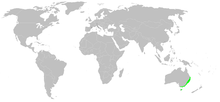Category:Deinopidae
Members of the family Deinopidae in the Suborder Araneomorphae
Pages in category "Deinopidae"
The following 9 pages are in this category, out of 9 total. This list may not reflect recent changes.
Members of the family Deinopidae in the Suborder Araneomorphae
The following 9 pages are in this category, out of 9 total. This list may not reflect recent changes.
Just testing to see how a message is posted.
Ken
Talk pages are where people discuss how to make content on Wikipedia the best that it can be. Start a new discussion to connect and collaborate with Sanwege. What you say here will be public for others to see.

This category has the following 4 subcategories, out of 4 total.
The following 2 pages are in this category, out of 2 total. This list may not reflect recent changes.
This article includes a list of general references, but it lacks sufficient corresponding inline citations. Please help to improve this article by introducing more precise citations. (February 2019) (Learn how and when to remove this template message) |
| Deinopis subrufa | |
|---|---|
 | |
| Females are light reddish brown | |
| Scientific classification | |
| Kingdom: | Animalia |
| Phylum: | Arthropoda |
| Subphylum: | Chelicerata |
| Class: | Arachnida |
| Order: | Araneae |
| Infraorder: | Araneomorphae |
| Family: | Deinopidae |
| Genus: | Deinopis |
| Species: | D. subrufa |
| Binomial name | |
| Deinopis subrufa | |
 | |
| Excludes New Zealand | |
| Synonyms[1] | |
| |
Deinopis subrufa (also called the rufous net-casting spider) is a species of net-casting spiders. It occurs in Australia (Queensland, New South Wales and Tasmania) and in New Zealand.[1] It is a nocturnal hunter, having excellent eyesight, and hunts using a silken net to capture its prey. They feed on a variety of insects – ants, beetles, crickets and other spiders. They can vary in color from fawn to pinkish brown or chocolate brown. Females are about 25 mm in body length, males about 22 mm. They are not dangerous to humans.
This species is often found on a few strands of web in forest, woodland and heathland, or on flat surfaces, for example on the outside of houses.
Deinopis subrufa was first described by Ludwig Koch in 1879.[1] The generic name is derived from deinos, Greek for "fearful", and opis, Greek for "appearance", hence the common name of "ogre-faced spiders". The species name subrufa is Latin for "slightly reddish".[citation needed]
This section does not cite any sources. Please help improve this section by adding citations to reliable sources. Unsourced material may be challenged and removed. (February 2019) (Learn how and when to remove this template message) |
Males will usually shed their last skin and then seek a suitable female to mate with. They will rest on the outer skirts of the female's web, and will gently pluck the web to show her that they are interested. Days after mating, the female then constructs a globular egg sac, approximately 10-12 mm in diameter. It is generally a light brown or fawn color with black specks on it and contains anywhere from 100-200 eggs. It is usually disguised and protected by a leaf. Once the female has constructed the egg sac and laid the eggs, she will usually leave it to its own protection. After around 3 weeks, the young hatch.
This article related to araneomorph spiders is a stub. You can help Wikipedia by expanding it. |